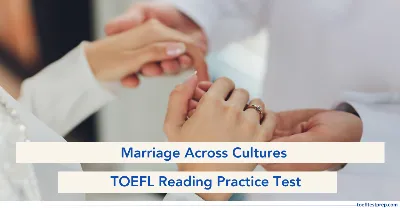Renaissance Masters - TOEFL Reading Practice Test

"Enhance your TOEFL reading skills with Renaissance Masters. Explore themes of innovation, art, and science that defined the Renaissance, mastering comprehension of historical and cultural passages for test success."
Key Highlights
Gaining proficiency in academic reading is essential for success in the TOEFL Reading section, which simulates the demands of English-language academic settings. This section assesses critical skills like identifying main ideas, gathering specific details, inferring meanings, and understanding text organization. Regular practice is crucial for high performance.
Our practice tests are designed to closely replicate the TOEFL's structure and language, helping you approach the exam with confidence. Take the TOEFL Practice Test on the "Renaissance Masters" passage to get familiar with the test format and identify key areas to improve!
Reading Instructions:
- You have 15 minutes to read the following passage and answer all 9 questions related to it.
- Most questions are worth 1 point, but the last question is worth more. The directions indicate how many points you will receive for that specific question.
- The specific section/paragraphs have been provided again with the question for ease of understanding and quick solution.
- Some questions include a word or phrase that is highlighted in the question as well as in the paragraph for quick reference.
Renaissance Masters
The Renaissance, a cultural change that grew from the 14th to the 17th century, represents an important period in European history marked by a revival of classical learning and a major change in art, literature, and thought. Originating in Italy, this era is noted for a renewed interest in the ideas and beauty of ancient Greece and Rome, which inspired artists and thinkers to explore human focus, perspective, and naturalism. The term "Renaissance," meaning "rebirth," perfectly captures the return of classical ideals and the emergence of new artistic techniques that would greatly influence Western art. Among the most well-known figures of this period are Leonardo da Vinci, Michelangelo Buonarroti, and Raphael Sanzio, each of whom made important contributions to the evolution of artistic expression and the representation of human experience.
Leonardo da Vinci, often seen as the ideal Renaissance man, embodied the blend of art and science. His masterpieces, such as "The Last Supper" and "Mona Lisa," showcase his skill in the light and shadow technique, which uses strong contrasts between light and dark to create depth. Da Vinci's careful attention to body detail and his deep understanding of human emotion allowed him to depict subjects with remarkable realism. His extensive notebooks reveal a mind that was not only artistically inclined but also curious about science, as he explored topics ranging from anatomy to engineering. This multi-field approach set a standard for future artists and thinkers, illustrating the Renaissance's focus on the connection of knowledge and the importance of observation.
Michelangelo, another towering figure of the Renaissance, is famous for his sculptural talent as well as his contributions to painting and architecture. His iconic sculptures, such as "David" and "Piet," represent the ideal human form and emotional intensity that became features of Renaissance art. Michelangelo's ability to convey human emotion through marble is especially impressive; his figures seem almost alive, filled with movement and energy. In addition to his sculptural work, Michelangelo's painting of the Sistine Chapel ceiling, particularly "The Creation of Adam," shows his new use of wall painting techniques and skill in depicting complex stories through visual art. His artistic impact is defined by a deep exploration of the human condition, reflecting the Renaissance's focus on individualism and the many aspects of human experience.
Raphael, often celebrated for his calm compositions and beauty, represents a different side of Renaissance art. His works, such as "The School of Athens," show the ideals of balance, proportion, and clarity that were central to Renaissance style. Raphael's ability to create unity among diverse figures and architectural elements in his works shows his mastery of perspective and spatial organization. His portraits, including "The Madonna of the Pinks," reveal a deep understanding of human emotion and subtle expression. Raphael's influence extended beyond his lifetime, as his works became a standard for beauty and grace in art, inspiring generations of artists who sought to imitate his style and approach.
While the contributions of these three masters are often highlighted, it is important to acknowledge the broader context of the Renaissance, which included many artists, thinkers, and innovations. The period saw the rise of printmaking, which helped spread artistic ideas and techniques across Europe. Artists like Albrecht Drer and Titian expanded the boundaries of Renaissance art by including elements from Northern European traditions, enriching the overall artistic landscape. Also, the support of wealthy families, like the Medici in Florence, played a crucial role in encouraging artistic innovation and providing artists with the resources needed to realize their visions. This collaborative atmosphere allowed for a flourishing of creativity that went beyond individual contributions, leading to a vibrant cultural scene.
The impact of the Renaissance Masters continues to echo in modern art and culture. Their exploration of human focus, perspective, and the natural world laid the groundwork for later artistic movements, including Baroque and Neoclassicism. Also, the Renaissance's focus on the value of personal expression and the pursuit of knowledge remains relevant today, influencing modern artistic practices and philosophical thought. As scholars and artists continue to study and reinterpret the works of da Vinci, Michelangelo, and Raphael, the Renaissance serves as a reminder of the lasting power of creativity and the human spirit. This period not only changed the landscape of art but also reshaped how humanity sees itself and its place in the world, leaving a lasting mark on the cultural heritage of Western civilization.
Directions: Once you have read the passage, answer the following questions.
Paragraph 1
The Renaissance, a cultural change that grew from the 14th to the 17th century, represents an important period in European history marked by a revival of classical learning and a major change in art, literature, and thought. Originating in Italy, this era is noted for a renewed interest in the ideas and beauty of ancient Greece and Rome, which inspired artists and thinkers to explore human focus, perspective, and naturalism. The term "Renaissance," meaning "rebirth," perfectly captures the return of classical ideals and the emergence of new artistic techniques that would greatly influence Western art. Among the most well-known figures of this period are Leonardo da Vinci, Michelangelo Buonarroti, and Raphael Sanzio, each of whom made important contributions to the evolution of artistic expression and the representation of human experience.
Factual Information Question
- According to paragraph 1, what does the term "Renaissance" mean?
- Revival
- Rebirth
- Renewal Kant
- Revolution
Negative Factual Information Question
- In paragraph 1, each of the following is mentioned as a characteristic of the Renaissance EXCEPT:
- A revival of classical learning
- A major change in art
- A decline in literature
- A renewed interest in ancient Greece and Rome
Paragraph 2
Leonardo da Vinci, often seen as the ideal Renaissance man, embodied the blend of art and science. His masterpieces, such as "The Last Supper" and "Mona Lisa," showcase his skill in the light and shadow technique, which uses strong contrasts between light and dark to create depth. Da Vinci's careful attention to body detail and his deep understanding of human emotion allowed him to depict subjects with remarkable realism. His extensive notebooks reveal a mind that was not only artistically inclined but also curious about science, as he explored topics ranging from anatomy to engineering. This multi-field approach set a standard for future artists and thinkers, illustrating the Renaissance's focus on the connection of knowledge and the importance of observation.
Inference Question
- What can be inferred about Leonardo da Vinci's approach to art and science?
- He believed art and science were unrelated fields.
- He saw art as a means to express scientific ideas.
- He considered both art and science equally important in his work.
- He prioritised scientific exploration over artistic expression.
Vocabulary Question
- The word "embodied" in paragraph 2 is closest in meaning to:
- Represented
- Created
- Ignored
- Complicated
Paragraph 3
Michelangelo, another towering figure of the Renaissance, is famous for his sculptural talent as well as his contributions to painting and architecture. His iconic sculptures, such as "David" and "Piet," represent the ideal human form and emotional intensity that became features of Renaissance art. Michelangelo's ability to convey human emotion through marble is especially impressive; his figures seem almost alive, filled with movement and energy. In addition to his sculptural work, Michelangelo's painting of the Sistine Chapel ceiling, particularly "The Creation of Adam," shows his new use of wall painting techniques and skill in depicting complex stories through visual art. His artistic impact is defined by a deep exploration of the human condition, reflecting the Renaissance's focus on individualism and the many aspects of human experience.
Rhetorical Purpose Question
- Why does the author mention Michelangelo's "David" and "Piet" in paragraph 3?
- To illustrate the decline of Renaissance art
- To highlight Michelangelo's mastery of sculpture
- To compare Michelangelo with Leonardo da Vinci
- To discuss the architectural features of the Renaissance
Paragraph 4
Raphael, often celebrated for his calm compositions and beauty, represents a different side of Renaissance art. His works, such as "The School of Athens," show the ideals of balance, proportion, and clarity that were central to Renaissance style. Raphael's ability to create unity among diverse figures and architectural elements in his works shows his mastery of perspective and spatial organization. His portraits, including "The Madonna of the Pinks," reveal a deep understanding of human emotion and subtle expression. Raphael's influence extended beyond his lifetime, as his works became a standard for beauty and grace in art, inspiring generations of artists who sought to imitate his style and approach.
Sentence Simplification Question
- Which of the following sentences best expresses the essential information in the following text from paragraph 4?
"Raphael's ability to create unity among diverse figures and architectural elements in his works shows his mastery of perspective and spatial organization."
-
- Raphael was skilled at combining different figures and architecture in his art.
- Raphael's works lacked unity and clarity.
- Raphael's art was primarily focused on architecture.
- Raphael did not understand perspective in his compositions.
Paragraph 5
While the contributions of these three masters are often highlighted, it is important to acknowledge the broader context of the Renaissance, which included many artists, thinkers, and innovations. The period saw the rise of printmaking, which helped spread artistic ideas and techniques across Europe. Artists like Albrecht Drer and Titian expanded the boundaries of Renaissance art by including elements from Northern European traditions, enriching the overall artistic landscape. Also, the support of wealthy families, like the Medici in Florence, played a crucial role in encouraging artistic innovation and providing artists with the resources needed to realize their visions. This collaborative atmosphere allowed for a flourishing of creativity that went beyond individual contributions, leading to a vibrant cultural scene.
Purpose of the Passage Question
- What is the main purpose of paragraph 5?
- To focus solely on the contributions of Leonardo, Michelangelo, and Raphael
- To discuss the broader context and influences of the Renaissance
- To highlight the decline of Renaissance art
- To compare Northern European art with Italian art
Paragraph 6
The impact of the Renaissance Masters continues to echo in modern art and culture. Their exploration of human focus, perspective, and the natural world laid the groundwork for later artistic movements, including Baroque and Neoclassicism. Also, the Renaissance's focus on the value of personal expression and the pursuit of knowledge remains relevant today, influencing modern artistic practices and philosophical thought. As scholars and artists continue to study and reinterpret the works of da Vinci, Michelangelo, and Raphael, the Renaissance serves as a reminder of the lasting power of creativity and the human spirit. This period not only changed the landscape of art but also reshaped how humanity sees itself and its place in the world, leaving a lasting mark on the cultural heritage of Western civilization.
Prose Summary Question
- Directions: An introductory sentence for a brief summary of the passage is provided below. Complete the summary by selecting the THREE answer choices that express the most important ideas in the passage. Some sentences do not belong in the summary because they express ideas that are not presented in the passage or are minor ideas in the passage. This question is worth 2 points.
The Renaissance Masters significantly influenced art and culture during the Renaissance period.
Answer Choices
-
- Their works exemplified the ideals of human focus and naturalism.
- The Renaissance was solely a product of the contributions of three artists.
- The support of wealthy patrons was crucial for artistic innovation.
- The impact of the Renaissance continues to resonate in modern art and thought.
Insert Missing Sentence Question
- In paragraph 6, there is a missing sentence. The paragraph is repeated below and shows four letters (A, B, C, and D) that indicate where the following sentence could be added.
"Their legacy is evident in various forms of contemporary artistic expression."
Where would the sentence best fit?
The impact of the Renaissance Masters continues to echo in modern art and culture. (A) Their exploration of human focus, perspective, and the natural world laid the groundwork for later artistic movements, including Baroque and Neoclassicism. (B) Also, the Renaissance's focus on the value of personal expression and the pursuit of knowledge remains relevant today, influencing modern artistic practices and philosophical thought. (C) As scholars and artists continue to study and reinterpret the works of da Vinci, Michelangelo, and Raphael, the Renaissance serves as a reminder of the lasting power of creativity and the human spirit. (D) This period not only changed the landscape of art but also reshaped how humanity sees itself and its place in the world, leaving a lasting mark on the cultural heritage of Western civilization.
-
- Option A
- Option B
- Option C
- Option D
Before moving forward to check your answers, don't forget to go through the updated TOEFL Exam Pattern and Syllabus.
Answer Key with Explanation for TOEFL Reading Passage - Renaissance Masters
1. Answer: B
Explanation: The passage explicitly states that the term "Renaissance" means "rebirth." This definition is crucial as it encapsulates the essence of the period, which involved a revival of classical ideals and artistic techniques.
2. Answer: C
Explanation: The passage highlights a revival of classical learning, a major change in art, and a renewed interest in ancient Greece and Rome. It does not mention any decline in literature, making option C the correct answer.
3. Answer: C
Explanation: The passage describes da Vinci as embodying a blend of art and science, indicating that he valued both fields. His exploration of various scientific topics alongside his artistic pursuits suggests he saw them as interconnected and equally significant.
4. Answer: A
Explanation: In this context, "embodied" refers to how Leonardo da Vinci represented the ideals of the Renaissance through his work. It implies that he personified or exemplified the blend of art and science characteristic of the era.
5. Answer: B
Explanation: The mention of these iconic sculptures serves to illustrate Michelangelo's exceptional skill in sculpture, showcasing his ability to convey human emotion and the ideal human form, which are central themes in Renaissance art..
6. Answer: A
Explanation: This option succinctly captures the essence of the original sentence, which emphasizes Raphael's ability to create unity among diverse elements in his works, showcasing his mastery of perspective and spatial organization.
7. Answer: B
Explanation: The paragraph emphasizes the contributions of various artists and the role of wealthy patrons in fostering a collaborative atmosphere during the Renaissance, indicating that it aims to provide a broader context rather than focusing solely on the three masters.
8. Answer: Options A, C and D
Explanation: These choices reflect the key ideas presented in the passage, highlighting the influence of the masters, the importance of patronage, and the lasting impact of the Renaissance on contemporary art and philosophy.
9. Answer: C
Explanation: The sentence about the legacy of the Renaissance Masters fits best after discussing the relevance of their focus on personal expression and knowledge, as it reinforces the idea that their influence is evident in contemporary artistic expression.
How did you handle the 'Renaissance Masters' reading test? Whether you find it challenging or not, we're here to support you. Keep practicing with our extensive collection of sample tests and build your confidence along the way!
Also Read:
Featured Articles

Marriage Across Cultures - TOEFL Reading Practice Test
Improve TOEFL Reading with passages on 'Marriage Across Cultures,' delving into unique traditions, values, and global perspectives on marriage.
July 15, 2025
Writing Center Services - TOEFL Speaking Practice Test with Answers (Integrated)
Prepare for the TOEFL Integrated Speaking section with a practice test on 'Writing Center Services' and learn to improve score in TOEFL exam.
July 15, 2025
Tutorial Room Booking - TOEFL Speaking Practice Test with Answers (Integrated)
Prepare for the TOEFL Integrated Speaking section with a practice test on 'Tutorial Room Booking ' and learn to improve score in TOEFL exam.
July 15, 2025
Textbook Rental System - TOEFL Speaking Practice Test with Answers (Integrated)
Prepare for the TOEFL Integrated Speaking section with a practice test on 'Textbook Rental System' and learn to improve score in TOEFL exam.
July 15, 2025